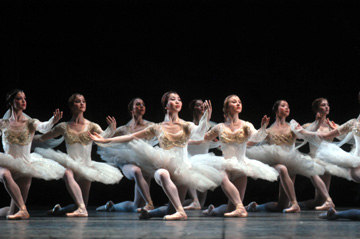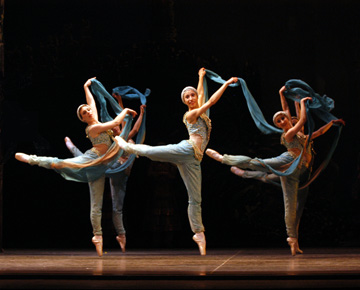Debuts, Good Dancing, in ABT's La Bayadère
La Bayadère
American Ballet Theatre
Opera House, Kennedy Center for the Performing Arts
Washington, DC
Friday, February 6 and Saturday February 7, 2004 at 7:30 PM
by
George Jackson
copyright 2004 by George Jackson
 Likely
the year was 1961, the place Madison Square Garden in Manhattan. The first
half dozen had entered, one by one, doing the same step and stretch. Would
others follow? I hoped so, and another half dozen did. Then I was afraid
they would stop. Couldn't they just keep coming on? The women of the full
Kirov corps did, descending the ramp in a grave cantilena of arabesques,
seemingly without end. It was bliss! Almost all New York succumbed to
the Shades of La Bayadere. The impact was immeasurable. Classicism,
minimalism and abstraction could no longer be seen as separate and opposed.
Modern dancers and painters started showing up at these performances.
Hatchets were buried and only Agnes de Mille dismissed the choreography
as trivial.
Likely
the year was 1961, the place Madison Square Garden in Manhattan. The first
half dozen had entered, one by one, doing the same step and stretch. Would
others follow? I hoped so, and another half dozen did. Then I was afraid
they would stop. Couldn't they just keep coming on? The women of the full
Kirov corps did, descending the ramp in a grave cantilena of arabesques,
seemingly without end. It was bliss! Almost all New York succumbed to
the Shades of La Bayadere. The impact was immeasurable. Classicism,
minimalism and abstraction could no longer be seen as separate and opposed.
Modern dancers and painters started showing up at these performances.
Hatchets were buried and only Agnes de Mille dismissed the choreography
as trivial.
I remember the shudder of pleasure caused by that first* sighting of the
Shades. A little later, probably in Brooklyn, New York saw another scene
from La Bayadere, a Canadian production. Still later, May 21,
1980, we were very thankful for Natalia Makarova's program filling production
for ABT.
 At
the first of the four current ABT performances of Makarova's La Bayadere
it was easy to forget our gratitude. By now we've gotten to know equal
and better versions of the Marius Petipa / Ludwig Minkus classic. Moreover,
first nights of programs at the Kennedy Center tend to be out of focus.
This past Friday's performance was no exception. The first bad omen was
that the tiger killed by Solor, the ballet's conflicted hero, didn't make
it onto the stage. The women's corps de ballet, crucial in more than the
Shades Scene, had worked hard to be uniform at the expense of being in
form— stylistically the ladies seemed stressed. Good individual
performances were scarce. Michele Wiles's Gamzatti came through spankingly
as a pride-filled, pitiless fighter for her arranged marriage. As expected,
Wiles was resplendent dancing. Her unsupported turns were rich and smooth,
her line had scope and showed satisfaction. Nuances of phrasing were at
her command. New this season was her acting. Wiles has learned to do it,
and when not actively acting, her features are consistent with the called-for
mood.
At
the first of the four current ABT performances of Makarova's La Bayadere
it was easy to forget our gratitude. By now we've gotten to know equal
and better versions of the Marius Petipa / Ludwig Minkus classic. Moreover,
first nights of programs at the Kennedy Center tend to be out of focus.
This past Friday's performance was no exception. The first bad omen was
that the tiger killed by Solor, the ballet's conflicted hero, didn't make
it onto the stage. The women's corps de ballet, crucial in more than the
Shades Scene, had worked hard to be uniform at the expense of being in
form— stylistically the ladies seemed stressed. Good individual
performances were scarce. Michele Wiles's Gamzatti came through spankingly
as a pride-filled, pitiless fighter for her arranged marriage. As expected,
Wiles was resplendent dancing. Her unsupported turns were rich and smooth,
her line had scope and showed satisfaction. Nuances of phrasing were at
her command. New this season was her acting. Wiles has learned to do it,
and when not actively acting, her features are consistent with the called-for
mood.
Jose Manuel Carreno's Solor was classically admirable in the Shades Scene's
climax. Otherwise, he was correct but without his élan. If one
thinks about Solor's character and behavior (undoubtedly, not something
one is supposed to do), he's hard to decipher. Like the hero of Aida,
Rhadames, Solor can't openly defy the potentate's command to marry his
daughter. Rhadames, though, by agreeing to escape, is braver than Solor
who reluctantly goes to the altar. Carreno wisely allowed motivations
to be vague. Given the Gamzatti of Wiles, no wonder he was attracted.
 Paloma
Herrera, Friday's Nikia, has lovely feet, Parisian feet in appearance
and action. Not at all a bad looking woman, she was, nevertheless, facially
uninteresting in the role. Herrera is trim at this time in her career,
but her dancing, which is so efficient, would gain if chose to play with
it a little. After all, Nikia, the ballet's heroine, is supposed to be
a dancer who pleases.
Paloma
Herrera, Friday's Nikia, has lovely feet, Parisian feet in appearance
and action. Not at all a bad looking woman, she was, nevertheless, facially
uninteresting in the role. Herrera is trim at this time in her career,
but her dancing, which is so efficient, would gain if chose to play with
it a little. After all, Nikia, the ballet's heroine, is supposed to be
a dancer who pleases.
Saturday night, Ethan Stiefel was the Solor, Stella Abrera the Gamzatti
and Brazil's Roberta Marquez made her American debut as the Nikia. Abrera
was strongly dramatic, especially in the confrontation scene with Nikia,
but her dancing was stiff. Stiefel worked hard to make his Solor stellar
and in a way he succeeded. Every moment was danced full out, and there
was a surplus of motivations. However, I liked him better earlier in the
week when, without forcing, he gave some backbone to Nacho Duato's spineless
Without Words choreography.
Marquez is a ballerina, not only unique as all ballarinas must be but
also odd. She's tiny with a tall woman's feet. She dances big. Her intensity
projects out and then boomerangs. Back to her it comes, and she absorbs
it. The result is slightly mad, as if in all her scenes Marquez were alluding
to Giselle at the end of Act 1. How will she handle other roles?
Almost everyone was better Saturday night than Friday. The corps and the
solo Shades were more stylish, Ethan Brown's potentate less monotone,
Herman Cornejo's Bronze Idol more meaty, the orchestra under Charles Barker
clearer. At the end of Friday's performance, this production of La
Bayadere seemed like something to ditch in favor of a better version.
Saturday night, thanks to Stiefel and Marquez and most others, it moved
the audience and showed that there's life left in the 24 year old item.
>>>>>>>>>>>>>>>>>>>>>>>>>>>>>>>>>>>>>>>>>>>>>>>>>>>>>>>>>>>>>>
* Pavlova danced La Bayadere in America early in the 20th Century,
but the thunder was all hers and people didn't seem to notice what she
was dancing. Nor is it clear how much and what portions of the entire
ballet she presented. A Soviet film of Dudinskaya, Chabukiani and the
Kirov women's corps in part of the Shades Scene was shown in America,
beginning probably in the late 1940s. However, this footage did not include
the entrance of the Shades.
Photos:
First: Kingdom of the Shades, Act II, La Bayadére. PHOTO:
Marty Sohl
Second: Paloma Herrera as Nikiya in La Bayadère. PHOTO: MIRA
Third: Djampe dance, Act I, La Bayadère. PHOTO: Marty Sohl
Originally
published:
www.danceviewtimes.com
Volume 2, Number 6
February 9, 2004
©
2004 George
Jackson
|
|